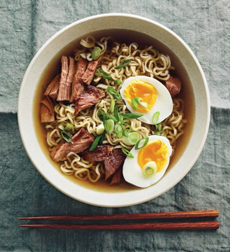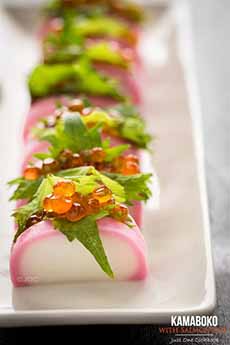Homemade Pork Ramen Soup Recipe In A Slow Cooker
 [1] Get out your slow cooker and create this delicious Japanese comfort food (photo © Williams Sonoma).
|
While many Americans think of ramen soup as one of the cheapest ways to feed oneself comfort food, in Japan the finest Japanese ramen soups take considerable culinary skill and many hours to create. Ramen is hearty enough to be a proper main course with some vegetable sides; but you can also use it as a soup course. The Williams Sonoma cookbook, Quick Slow Cooking, offers a simplified, yet still delicious, version that uses plenty of succulent braised pork. Another key to a glorious dish is high-quality, fresh ramen noodles, available at Asian markets. If you can’t find them, use fresh thin Chinese egg noodles or fresh linguine. If you can’t get any fresh pasta, you can default to packaged ramen noodles. Another point of differentiation from packaged ramen soups: yummy toppings. These can include: For example, the recipe below specifies scallions and soft boiled eggs, but you can switch them out or add other toppings. This recipe uses a slow cooker. For more inspiring slow cooker recipes, check out Quick Slow Cooking by Kim Laidlaw. > April 4th is National Ramen Day. > July 11 is Japanese National Ramen Day. > The history of ramen is below. > All the soup holidays. Ingredients For 8 Servings 1. SEASON the pork with salt. Place a large sauté pan or the stove top–safe insert of a slow cooker on the stove top over medium-high heat. Add the oil and warm until hot. Working in batches if necessary to avoid crowding, add the pork pieces and sear them on the first side without moving them until well browned, 3 to 4 minutes. Turn the pieces and sear on the second side until well browned, 3 to 4 minutes longer. Transfer to a plate and set aside. |
|
|
2. POUR off all but 2 tablespoons of the fat from the insert or sauté pan and return the insert to medium-high heat. Add the yellow onion and sear, without stirring, until browned, about 5 minutes. Stir in the garlic, ginger, and 1 cup (250 ml) of the broth. Deglaze the sauté pan or insert, stirring and scraping up any browned bits from the insert bottom; then let simmer for 1 minute. If using a sauté pan… 3. TRANSFER the contents of the pan to the insert of a slow cooker. Add the leek, mushrooms and the remaining 7 cups (1.75 l) of broth; stir to combine. Cover and cook on the low setting for 8 hours. The pork should be very tender and the broth should be fragrant. 4. TRANSFER the pork to a cutting board. Using 2 forks, break the pork into bite-size chunks, removing and discarding any large pieces of fat. Strain the broth through a fine-mesh sieve into a bowl and discard the solids. Using a large spoon, skim off and discard any fat from the surface of the broth. Return the pork and broth to the slow cooker and season to taste with soy sauce and sesame or chile oil. Cover and cook on the low heat setting for about 30 minutes to warm through. 5. COOK the ramen noodles according to the package directions. Put the eggs into boiling water and simmer for 5 to 6 minutes. Remove the eggs from the water, let cool until they can be handled and peel them. Cut each in half lengthwise. 6. TO SERVE: Divide the noodles evenly among individual bowls. Ladle the broth and pork over the noodles, dividing them evenly, then sprinkle with the scallions. Top each bowl with two soft-boiled egg halves and serve immediately. Ramen is a dish of noodles in meat broth—chicken or pork—that originated in China. It differs from native Japanese noodle soup dishes, in that until ramen appeared, Japanese broth was based on either vegetables or seafood. The type of noodles and toppings used in ramen also came from China. It is believed that “ramen” is the Japanese pronunciation of the Chinese word “lamian,” meaning “hand-pulled noodles” (as opposed to noodles that are sliced with a knife). While some ramen dishes began to appear in Japan in the late 1600s, they didn’t become widespread until the Meiji Era (1868 through 1912), when Japan moved from being an isolated feudal society to a modern nation. Foreign relations and the introduction of meat-based American and European cuisines led to increased production of meat, and played a large role in the growing popularity of ramen. Almost every locality or prefecture in Japan created its own variation of the dish, served at restaurants. The growth of ramen dishes continued after World War II, but was still a special occasion that required going out. In 1958, instant noodles were invented by Momofuku Ando, founder and chairman of Nissin Foods. Named the greatest Japanese invention of the 20th century in a Japanese poll, instant ramen allowed anyone to make this dish simply by adding boiling water. Exported, these ramen soup packages soon became a pop culture sensation across the globe. Soup recipes and methods of preparation are closely-guarded secrets in many restaurants. Beyond regional variations, innovative Japanese chefs continue to push the boundaries of ramen cuisine. Curry ramen, invented in the Hokkaido region, became a national favorite, as has ramen based on the Chinese dish of shrimp in chili sauce. Non-Japanese ingredients such as black pepper and butter have found their way into recipes. Check out this article, which details the different type of ramen by region. *Kamaboko is a type of surimi, a Japanese processed seafood product of which crab stick is another variety. To make surimi, white fish are pureed and mixed with flavor and color. Kamaboko is formed into a half moon-shaped loaf and the outside is colored pink over a white center. Nori is the dried seaweed used to make sushi rolls. CHECK OUT WHAT’S HAPPENING ON OUR HOME PAGE, THENIBBLE.COM. |
||





